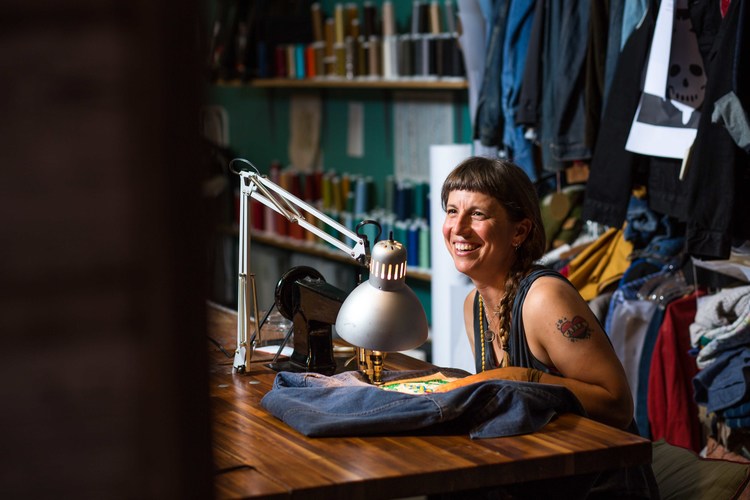Five steps to “crafting” a work-from-home career
By Christi J. Schwanbeck
Rat Race Contributing Writer
In a modest studio in Austin, Texas, Kathie Sever has been reviving the ancient craft of chain stitch embroidery.
I met Sever at her backyard studio in Austin’s Barton Hills neighborhood. As I walked the narrow path leading to the backyard gate, I caught a glimpse of the small shed-like building which housed her studio and inventive designs. At the gate, I was greeted by a quirky and sweet rescue dog.
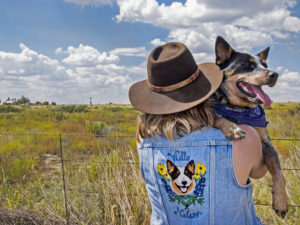
Through the studio window, shelves of colorful thread spools set the backdrop for a long wooden table lined with black chain stitching machines, a few of them currently in play by Sever’s “storystitchers,” a term she coined to describe their craft. Sever’s company, Fort Lonesome, is now established as one of the biggest chain stitch shops around, but it certainly didn’t start out this way.
Setting a goal: Making a living from home
Sever’s mother was a sewing teacher, and she has always sewn as a hobby. After art school, Sever established a career as a pastry chef. But in 2000, after the birth of her first child, she began looking for a way to making a living from home. “Once Ramona came along, I wasn’t sure how I would go back to work,” she said.
Sever’s husband is Matthew Sever, more famously known as “Matt the Electrician” in the folk/Americana music world. With a notable music career spanning over 20 years and a dozen records, Matt’s performance schedule has him on the road many days out of the year. “We were just trying to figure out if Matt could continue to do music, which would mean that if I was working, we would just be paying so much money in child care,” Sever said. “Plus, I just really wanted to be able to stay home with the kids.”
Using the networking resources at hand
Around that time, Sever met a friend who happened to be working on a business plan for a children’s accessories line. “She was doing children’s oilcloth accessories and a few little apparel pieces. She needed a sample maker, so I made her samples, but then I was also sewing on the side,” Sever said. “She had manufacturing, she had a rep, and I was just kind of along for the ride. But then the stuff just started getting picked up by stores.”
That was how the children’s clothing line Ramonster was launched, albeit “not super purposefully,” Sever said. “It just sort of happened.” While designing Ramonster over the next five or six years, Sever ended up making a purchase that would eventually create a customer list to include talk show host Jimmy Kimmel and filmmaker Richard Linklater, partnerships with such brands as Levi’s and Ralph Lauren, as well as collaborations with individuals from around the world who want a custom, one-of-a-kind, hand drawn chain-stitched piece to tell their own story. It would even lead to a request to design a custom shirt for Matthew McConaughey for his role in the film Dallas Buyer’s Club.
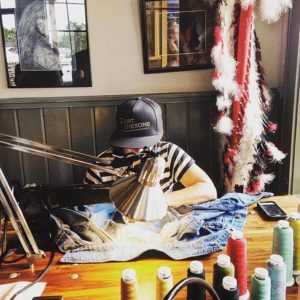
That fateful purchase was a vintage Singer chain stitch embroidery machine. “A friend of mine who I knew from kids’ clothing happened to have bought one but didn’t know how to use it and couldn’t figure it out,” Sever said. “I was doing the children’s western wear line and she knew that the machines had a history with western wear, so she offered to sell it to me. And I bought it.” She added with a laugh, “And then I couldn’t figure it out for a really long time.”
Sever started to phase out the children’s line around 2005-2006 as she received more requests for her adult custom western wear. As she began to focus more on adult clothing, Sever changed the name of her company to Fort Lonesome, with a focus on custom adult designs. She kept tinkering with the chain stitch machine but couldn’t quite get it working.
But then Sever came across a man named Jerry, who, more than a thousand miles away in Indianapolis, had come across the same type of embroidery machine and was also trying to learn how to use it. “He and I just started emailing and trying to figure it out together,” Sever said. “He was very helpful, and when I finally got it going and felt more confident in it, I realized that there were all these other things that these machines could do.”
While the chain stitch embroidery technique can be traced as far back as the third century BC in China, it has a “long and storied history with denim,” Sever said. According to Sever, chain stitch embroidery offers a craftsman a particular kind of artistic freedom. “It’s kind of like using an etch-a-sketch, where you can draw your pattern on,” she said. “You can do this with a regular sewing machine if you’re using a free-motion stitch, but the machines I use are designed specifically for free-motion embroidery with a chain stitch, which is a kind of fatter, chunkier stitch.”
Another benefit to this specific type of machine is that it doesn’t require the needle to pass through more than one layer of fabric. This is what makes it especially suited to working with denim fabric. The sewer is able to add embellishments very close up to the seam. This also allows it to be helpful in creating designs on other textiles like hats, banners, pillows, jackets, and patches.
“Sometimes we’ll just do it free-hand, sometimes we’ll draw the pattern onto the fabric,” Sever said. “Sometimes we’ll just draw it onto a piece of stabilizer and follow the lines that we’ve already drawn. It just depends on the kind of fabric and what we’re doing.” Sever said she particularly likes the way the process allows for a lot of artistic collaboration. “There’s no digitization involved,” she said. “With each piece, you’re sitting there coloring it in and drawing it out.”
Identifying a trend
In 2013, after focusing just on the custom adult wear for several years and achieving mastery of the machine, Sever decided to completely remake Fort Lonesome’s corporate image one more time. She brought the old chain stitch embroidery machine to the forefront of the business. “There was a lot of interest in this kind of embroidery, and I was out ahead of it because I was watching it,” she said.
Sever had been active in the do-it-yourself community and had a close eye on just how fascinated this subculture had become with domestic manufacturing and old sewing machines, as well as all of the other machines involved in making denim. “I realized that nobody knew anything about these chain stitch embroidery machines, and I was sitting on one and figuring it out,” Sever said. “So when I relaunched, I relaunched bigger, and very quickly I had to start hiring people. There are just so many applications.”
Customization is the key component. “It’s very collaborative,” Sever said. “It’s one thing when you’re making your own thing and trying to sell it to people. It’s another thing when you’re saying: ‘Hey, I can make this for you.’ ‘I can make this for your company.’ ‘I can take your logo and put it on a bunch of jackets.’ ‘I can take your artwork and make it into a bunch of [hand-drawn] patches or whatever.’”
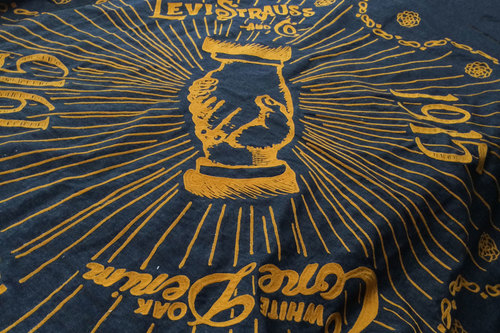
Partnerships with other companies have become a core component of Fort Lonesome’s business. “So much of what we do now is in service of some other brand,” Sever said. After the 2013 rebranding of Fort Lonesome, Sever’s current business model took off almost overnight. “Everything just changed in a short period of time,” Sever said. “Western wear was now a piece of a bigger puzzle of what we did vs. having a ‘clothing line.’” Word of mouth brought more business, which brought more exposure, which brought new opportunities and unique collaborations. “It’s one of those funny things,” Sever said. “One thing just lead to another . . . and to another. I think I can trace a lot of it back to doing work for Richard Linklater. His significant other was my doula and a good friend of my midwife and was a friend of mine. She ordered some shirts for Rick. He ordered some shirts for his friends like Ethan Hawke and Matthew McConaughey.”
The shirt Sever made for Matthew McConaughey was in the preview of the film Dallas Buyers Club, but she believes it may have been cut from the full-length feature. “That was a funny thing,” Sever said. “That taught me about press!” She has no idea how people would even hear of the shirt, yet many people came up to her out of the blue asking about it. “They would come up and ask me if I had done this shirt for Matthew McConaughey in Dallas Buyer’s Club, and I would say, every single time, ‘Yes! But I think it got cut!’” she laughed. Western wear fans were still excited about the appearance, even if it didn’t make it into the feature.
Another string of connections, which resulted from Linklater’s support, started with a custom shirt commission for Jimmy Kimmel during his Jimmy Kimmel Live broadcast at SXSW. Kimmel was so excited about Fort Lonesome’s shirts, that he commissioned one as a birthday present, complete with monogrammed cuffs and armadillos, for his Austin-loving friend Bill Murray. The growing publicity then began to attract interest from major clothing brands. The fact that old-fashioned chain stitch machines have a long history with denim was a special benefit in the corporate partnership area. “Levi’s was always on the lookout for people who could do this type of embroidery, so I got hooked up with them,” Sever said. This deal with Levi’s was a boon to the Fort Lonesome brand, leading to even more opportunities.
Combining craft with marketing
Another way Sever has been able expand her business is through on-site appearances at festivals such as the Trans-Pecos Festival of Music and Love in Marfa, Texas, and the prestigious Newport Folk Festival. “The on-site business segment has brought great opportunity for visibility and connections,” Sever said. “It has really helped spur us on.”
The on-site arrangements vary, depending on the event and whether Fort Lonesome is working solo or in tandem with the festival or a brand. “We are an ‘activation,’” Sever said. “That’s what it’s called in the corporate world. [It’s] a way for the corporate brand to get people interested in what they are trying to promote.” Clothing companies can use Fort Lonesome’s on-site work to promote the versatility and potential of their products. “All of these denim companies see us and our ability to do on-site customization stuff for people and they like that,” Sever said, “so they bring us different places.”
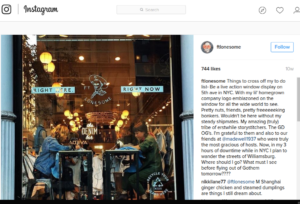
Willie Nelson’s annual Luck Reunion, an event celebrating musicians, artisans, and Americana, invited Sever to come work on site at one of their events. “Luck asked us to come and do it out there,” Sever said. Each on-site activation is different. “Sometimes we do it in conjunction with Levi’s or sometimes we do it on our own,” Sever said. “Last year we did it with Imogene + Willie, and this year we did it with Madewell.”
Many of these brand collaborations come with their fair share of fringe benefits. From Levi’s jeans and t-shirts, to outfits from Madewell and other trendy clothing companies, to cases of Austin’s local High Brew coffee and an undisclosed number of bottles of Crown Royal, there is often fun stuff to share with friends.
Newport and Trans-Pecos have been Sever’s favorite events so far. “At Trans-Pecos, people are more familiar with what we do, so they will bring their own clothes, and we’ll make a huge banner full of different little pieces of art they can purchase,” she said. “I have made many, many custom shirts for Jay Sweet [executive producer of the Newport Folk Festival]. He’s always worn them and been a good supporter of ours.”
Making the transition to living off your handiwork
If you are a devoted crafter hoping to make a living with the work you love, Sever suggests you try to find common ground between your passions and the demands of the market. “You have to be really, really savvy,” she said. “It’s worth it to balance out what it is you want to do with trying to figure out what the market demands to a certain extent.” Pursuing your dream is worthwhile, but so is being willing to tweak that dream to respond to what customers want. “It’s great if you have the flexibility to just do what you want to do,” Sever said. “But in my experience, it’s a perpetual state of ‘Here’s what we want to do, and we’re going to put it out there. But, we’re going to put it out there alongside offering our services for other people.’” Sever tries to make sure everything Fort Lonesome does is filtered through its own artistic lens, but part of keeping that balance includes taking on projects where they are more or less technicians for an outside brand.
“You just have to flush out all the relevant ways you can use your skills in the marketplace . . . if your goal is financial stability,” she said. “But then, that has to be in service of the bigger picture. That’s the struggle: Trying to balance the stuff that feeds you [creatively] and the stuff that pays the bills.” Sever noted that as a business, if you are interested in working with other people, creating sustainable jobs and being fair to those you are already working with, you have to be willing to be more creative with how you bring work in. “That’s what has been interesting for me, too, is bringing other people in,” she said. “It’s great! But then I feel really responsible for them, which forces me to get really savvy about how we can all stay in play.”
This fall, Fort Lonesome has undergone yet another change: As of September they are now playing in a bit of a bigger space on Austin’s east side. Fort Lonesome has outgrown the modest backyard studio where Stevie the rescue dog will greet you at the door and kids can be heard jumping around on the trampoline.
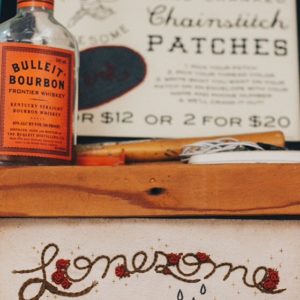 The new location is not as roomy as Sever would have liked, but it will offer a little bit more space. “Hopefully, we can now split up the production work from the custom work,” she said. It will be her first time working outside of the house in quite a while, but it’s a move that’s necessary to grow with the demand—and house her collection of nine vintage chain stitch embroidery machines (six of which are in working order.) Yes, somewhere between 2004 and today, she managed to find, one by one, eight more precious machines.
The new location is not as roomy as Sever would have liked, but it will offer a little bit more space. “Hopefully, we can now split up the production work from the custom work,” she said. It will be her first time working outside of the house in quite a while, but it’s a move that’s necessary to grow with the demand—and house her collection of nine vintage chain stitch embroidery machines (six of which are in working order.) Yes, somewhere between 2004 and today, she managed to find, one by one, eight more precious machines.
As we ended the interview, Sever remembered that they had just sent off a shirt to Will Ferrell. Oh darn, I guess it’s too late to include me in that box! But she did send me home with a gift of Crown Royal and an assortment of High Brew coffee. Yum.
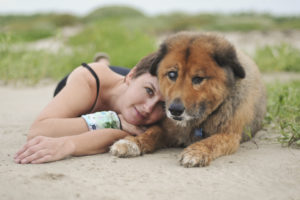 Christi J. Schwanbeck is a storyteller, music lover and volunteer animal rescue & welfare advocate who lives in Austin, Texas, with her assortment of street-rescued animals. New to Austin, she is open to new business or creative opportunities to collaborate with others. She hopes that one day she will be able to write her own story on how she paved the path to the career of her dreams. She is currently in the beginning stage of writing a book about her journey rehabilitating a family of feral dogs she rescued off the streets of Houston in 2013.
Christi J. Schwanbeck is a storyteller, music lover and volunteer animal rescue & welfare advocate who lives in Austin, Texas, with her assortment of street-rescued animals. New to Austin, she is open to new business or creative opportunities to collaborate with others. She hopes that one day she will be able to write her own story on how she paved the path to the career of her dreams. She is currently in the beginning stage of writing a book about her journey rehabilitating a family of feral dogs she rescued off the streets of Houston in 2013.
